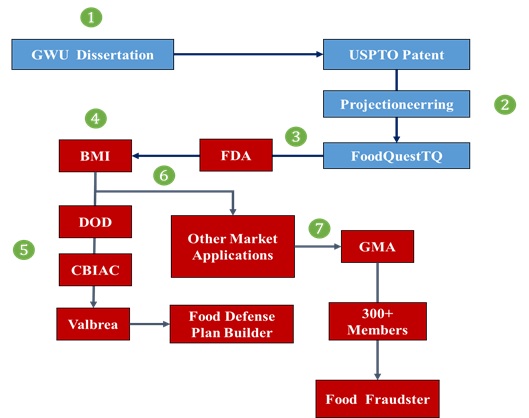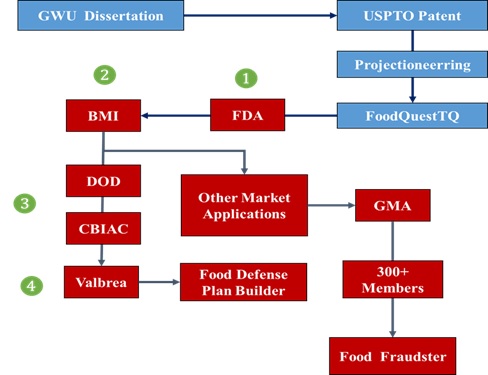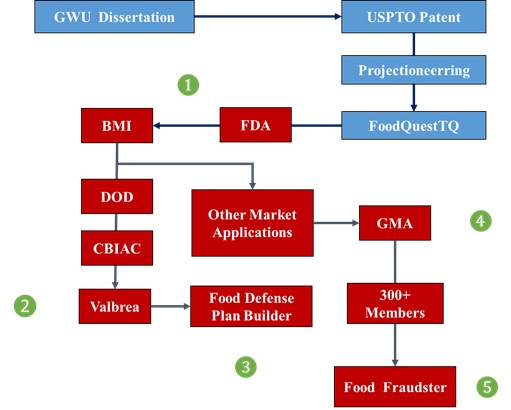by: John Hnatio. EdD, PhD
 The Sherman Anti-Trust Act, was the first Federal law to outlaw monopolistic business practices. The Sherman Act authorized the Federal Government to dissolve “trusts” engaged in anti-competitive conduct that harmed the consumer.
The Sherman Anti-Trust Act, was the first Federal law to outlaw monopolistic business practices. The Sherman Act authorized the Federal Government to dissolve “trusts” engaged in anti-competitive conduct that harmed the consumer.
The Sherman Act also declared that any actions “in the form of trust or otherwise that was in restraint of trade or commerce among the several states, or with foreign nations” was now against the law. Persons engaging in anti-competitive conduct were subject to fines and possible incarceration. Individuals and companies suffering economic losses because of anti-competitive conduct could now sue in Federal court for treble damages.
The broadly worded nature of the Sherman Act, however, left much room for subsequent interpretation by the Courts. Just five years after the Sherman Act was passed the Supreme Court, in the case of the United States v. E. C. Knight Company (1895), ruled that the American Sugar Refining Company was not in violation of the law even though the company controlled about 98 percent of all sugar refining in the United States. The Court reasoned that the company’s control of manufacture did not necessarily constitute “a control of trade.”
 However, other decisions by the courts have resulted in the dissolution of monopolistic giants like the Northern Securities Company of Minnesota, Standard Oil and the American Tobacco Company. In more recent years, the Federal Government has relied on the Sherman Act to stop predatory anti-competitive conduct by the software super-giant Microsoft.[i]
However, other decisions by the courts have resulted in the dissolution of monopolistic giants like the Northern Securities Company of Minnesota, Standard Oil and the American Tobacco Company. In more recent years, the Federal Government has relied on the Sherman Act to stop predatory anti-competitive conduct by the software super-giant Microsoft.[i]
In 1914, in an attempt to clarify and supplement the Sherman Act Congress passed the Clayton Antitrust Act. The Clayton Act made significant modifications to federal antitrust law. The focus of the Clayton Act was to deter and prevent anti-competitive practices in their embryonic stages. Significantly, the Act seeks to stop anti-competitive practices by prohibiting particular types of conduct, not deemed in the best interest of a competitive market.[ii]
Under-girding all antitrust law in the United States is the fundamental principle that the Federal Government will serve as the honest broker by abiding by the principles of antitrust law and enforcing it as necessary to preserve open and fair competition in the marketplace.
 Today, however, the expanding role of the Federal Government has grown to include the production of goods and services in direct competition with the private sector where the Federal Government has placed itself in the awkward position of engaging in anti-competitive conduct in collusion with groups of their own preferred contractors. Nowhere is this more evident than Federal Government agencies that exercise regulatory oversight over the different critical infrastructures of our society including energy, healthcare, pharmaceuticals, transportation, food and agricultural and others.
Today, however, the expanding role of the Federal Government has grown to include the production of goods and services in direct competition with the private sector where the Federal Government has placed itself in the awkward position of engaging in anti-competitive conduct in collusion with groups of their own preferred contractors. Nowhere is this more evident than Federal Government agencies that exercise regulatory oversight over the different critical infrastructures of our society including energy, healthcare, pharmaceuticals, transportation, food and agricultural and others.
By way of example, let us consider a case involving the actions of the Food and Drug Administration (FDA) and a small high technology business. The FDA has regulatory responsibility for approximately 80% of the U.S. food supply. What is most interesting in this case, however, is that the FDA, Battelle Memorial Institute (BMI) and the Grocery Manufacturers Association have all conceded guilt.
In this example, the FDA misappropriated the patented ideas and trade secrets of a small high technology start-up company. The technology involved what is called predictive analytics. Predictive analytics is the collection and mathematical treatment of massive amounts of data, i.e., big data, to help determine what may and what may not happen in the future as complex systems evolve.[iii] In 2014, the major investment broker Gartner estimated that the move to big data including predictive analytics will drive a $212 billion investment in information technology (IT) through the year 2016.[iv]
What Happened?
Figure 1: What Happened?
❶ The story begins at The George Washington University when a doctoral student conducted some of the first research on applying the science of predictive analytics to the behavior of complex systems including energy production and distribution, water availability and distribution, cyber networks, transportation, healthcare, food and agriculture and all of the other critical infrastructures on which our society depends.[v]
❷ After he graduated, the new doctor got a patent[vi] on his inventions and started two companies. The first company called Projectioneering LLC was established to serve as an intellectual property holding company for applying his patents across all of the critical infrastructures of our society. He also started up a company called FoodQuestTQ LLC to specifically apply his patented ideas and trade secrets across the food and agricultural vertical. One of the principal goals of FoodQuestTQ’s predictive analytics was to prevent food emergencies and the deaths and illnesses associated with intentional or accidental food poisoning—the types of things that cost the food industry hundreds of millions of dollars each year and cut sharply into their profits because of the low profit margins that characterize sales in the food industry.
❸ In developing their new line of predictive analytic food safety risk management tools FoodQuestTQ LLC met with FDA officials and even submitted a proprietary proposal to the FDA’s Joint Institute for Food and Nutrition (JIFSAN) and the Center for Food Safety and Applied Nutrition (CFSAN). The proposal was rejected and the FDA simply misappropriated the patented ideas and trade secrets contained in the proposal.[vii]
❹ Battelle Memorial Institute (BMI), one of the world’s largest non-profit scientific research and applied engineering organizations, is one of FDA’s principal contractors.
❺ Coincidentally, BMI also serves as a principal contractor to the Department of Defense (DOD). BMI in collusion with their FDA contract suitor and DOD facilitated an illegal “pass through” noncompetitive subcontract via DOD’s Chemical and Biological Information Assurance Center (CBIAC) to duplicate FoodQuestTQ’s products. The non-competitive subcontract went to a small technology company called Valbrea Technologies. Valbrea Technologies was paid by the U.S. Government to duplicate FoodQuestTQ’s food defense planning software. FDA then copyrighted the duplicated software as the property of the U.S. Government and provided it to the food industry free of any charge.
❻ Meanwhile, BMI diverted the predictive analytic technology they misappropriated from FoodQuestTQ LLC in collusion with the FDA to increase the profitability of their own line of commercial predictive analytic tools for food safety and across other industry verticals. A sampling of these BMI commercial tools include PRIATM, Smart VisionTM, Way Finder, EluciDataTM and many others. (http://www.battelle.org/our-work/consumer-industrial/consumer-products/food-beverage).
❼ With the help of the FDA, and as part of BMI’s efforts to expand their own foothold in the predictive analytics food safety risk management market, BMI colluded with the Grocery Manufacturer’s Association (GMA) to use FoodQuestTQ’s patented ideas and trade secrets to duplicate their Food Fraudster tool.
Bid Rigging by FDA, DOD and Battelle
Figure: FDA, BMI and DOD Engage in Bid Rigging
❶ Bid rigging is a form of fraud in which a commercial contract is promised to only one party. In the case of FoodQuestTQ, the first predatory and anticompetitive conduct occurred when FDA saw a technology that they wanted—in this case predictive analytic tools that would allow them to prevent food emergencies before they happen. FDA desperately needed the technology in response to public and Congressional criticism about their slow response to improve the safety of the food supply.
❷ The FDA rather than following procurement laws to lawfully acquire the technology simply misappropriated it. They faced the possibility of public embarrassment if they did not “come up with the “goods” because of their own promises to Congress in the National Food Protection Plan in which the FDA itself proclaimed that they would be internally building advanced computer software tools for the food industry.[viii] The FDA could not afford to be publicly trumped by a little company like FoodQuestTQ as the source of predictive analytic tools that could prevent food emergencies. The agency’s future budget allocations from Congress depended on their ability to deliver on their promises. The FDA considered FoodQuestTQ as nothing more than collateral damage.
❸ BMI then colluded with two of their most important contract suitors, i.e., the FDA and DOD, to bypass a huge body of federal procurement and procurement integrity law specifically designed to prevent the U.S. Government itself from violating the Sherman and Clayton Acts.
❹ In this example, BMI facilitated a non-competitive “directed by-pass” contract via DOD’s Biological and Chemical Information Assurance Center (CBIAC) to a single pre-selected contractor, i.e., Valbrea Technologies, to duplicate the predictive analytics technology FDA and BMI originally misappropriated from FoodQuestTQ.[ix]
Price Fixing by FDA, BMI and GMA
Figure: Price Fixing by FDA, BMI and GMA
❶ Price fixing is an agreement between participants in the same market to buy, sell, or maintain the price of a product at an artificially fixed price. In the case of FoodQuestTQ, the first step in fixing the price of their food risk management predictive analytic software took the form of collusion between FDA and their support contractor, BMI, to avoid procurement laws that preclude the U.S. Government from engaging in bid rigging or price fixing.
❷ Step two consisted of FDA, BMI and DOD colluding to let an unlawful non-competitive contract to one of DOD’s preferred subcontractors, Valbrea Technologies. Valbrea was paid under a U.S. Government contract to use the misappropriated predictive analytic technology to duplicate FoodQuestTQ’s already existing food defense planning tools.
❸ Soon thereafter, FDA publicly announced the release of their own Food Defense Plan Builder tool that duplicated the FoodQuestTQ software. FDA immediately claimed copyright ownership of the duplicated software and began to provide it to the food industry free of charge. The result of the FDA, BMI and DOD collusion served to fix the price of the new predictive analytic software tool at $0 cost to the food industry. It also served to transform the originally patented predictive analytic technology licensed by Projectioneering LLC to FoodQuestTQ into a $0 cost generic enabling technology solution for use across all other industry verticals.
❹ BMI, seeking to expand its own competitive foothold in the burgeoning multi-billion dollar market for predictive analytics, colluded with FDA and GMA to duplicate another FoodQuestTQ software tool that uses predictive analytics to prevent food fraud. This time, a member company of GMA, Cargill Inc., gave a public briefing that BMI and GMA were working together to develop a new predictive analytic tool to combat food fraud. The briefing contained the same misappropriated predictive analytic technology originally stolen by the FDA and BMI from FoodQuestTQ. In this case GMA was pooling the resources of its member companies to duplicate FoodQuestTQ’s already existing Food Fraudster predictive analytic software to produce an artificially low cost software solution for use by their GMA member companies.[x]
Harm to the Consumer
It would be easy to mistakenly conclude that the actions of the FDA, DOD, BMI and GMA are not that significant. After all, the fact that computer software tools for preventing food poisoning are being made broadly available to the food industry at low cost can only good for the public safety and the consumer. Right?
Well, unfortunately the answer is not as simple as that. Innovation by small companies is at the heart of practical solutions. For every problem we solve today there are nothing but equally vexing problems to solve tomorrow. An economic system that rewards entrepreneurs for their creativity in solving new problems is at the heart of a safe food supply.
The government has a poor track record of innovation. In our system we rely on entrepreneurs to do this heavy lifting for the government. By their predatory and anticompetitive actions FDA, DOD, BMI and GMA are compromising our ability to find the innovative solutions we are surely going to need to solve the next intractable problems that threaten the safety of the food supply. Government misappropriation of technology from entrepreneurs only serves to stifle innovation by eliminating the rewards system that stimulates problem solving. In the end, consumers rely on this rewards system to keep the food they eat safe.
The entire story of FoodQuestTQ LLC and the concessions of guilt by the FDA, Battelle memorial Institute and the Grocery Manufacturer’s Association can be found at the John Galt Program for Investigative studies website at https://jgpis.org
[i] Sherman Anti-Trust Act, July 2, 1890; Enrolled Acts and Resolutions of Congress, 1789-1992; General Records of the United States Government; Record Group 11; National Archives. Retrieved from the World Wide Web on August 1, 2015 at: http://www.ourdocuments.gov/doc.php?flash=true&doc=51
[ii] Clayton Anti-Trust Act of 1914 (P.L. 63–212, 38 Stat. 730, enacted October 15, 1914, codified at 15 U.S.C. §§ 12–27, 29 U.S.C. §§ 52–53). See: http://www.infoplease.com/encyclopedia/history/clayton-antitrust-act.html
[iii] John Galt Program for Investigative Studies (November 2014). The case of FoodQuestTQ: The Food and Drug Administration is implementing a criminal scheme to destroy small business. Retrieved from the World Wide Web on August 1, 2015, at:
https://jgpis.org/the-story-of-foodquesttq/foodquesttq-fbi-report/
[iv] Alpine Data Labs (January 2014). Market stats: What’s the “True” size of the predictive analytics market? Retrieved from the World Wide Web on August 1, 2015, at: https://alpinenow.com/blog/market-stats-whats-the-true-size-of-the-predictive-analytics-market/
[v] Hnatio, J. (2006) “The complexity systems management method: A next generation decision support tool for the management of complex challenges at institutions of higher education,” (dissertation). Washington, DC: The George Washington University.
[vi] Hnatio, J. (2012). Complexity systems management method. USPTO patent no. US 20110173146 A1. Retrieved from the World Wide Web on August 1, 2015, at: http://www.google.com/patents/US20110173146
[vii] John Galt Program for Investigative Studies (November 2014). The case of FoodQuestTQ: The Food and Drug Administration is implementing a criminal scheme to destroy small business. Retrieved from the World Wide Web on August 1, 2015, at:
https://jgpis.org/the-story-of-foodquesttq/foodquesttq-fbi-report/
[viii] Food and Drug Administration (2007). The national food protection plan. Retrieved from the World Wide Web on August 1, 2015, at: http://www.fda.gov/Food/GuidanceRegulation/FoodProtectionPlan2007/ucm132565.htm
[ix]John Galt Program for Investigative Studies (November 2014). The case of FoodQuestTQ: The Food and Drug Administration is implementing a criminal scheme to destroy small business. Retrieved from the World Wide Web on August 1, 2015, at:
https://jgpis.org/the-story-of-foodquesttq/foodquesttq-fbi-report/
[x] Ibid.
Related articles and updates:
- The FDA stole our stuff
- Antitrust Violations
- FBI Corruption
- FDA gets caught and admits guilt press release
- FDA gets caught and admits guilt interview (video)
- FDA full affidavit
- FBI report with full details
- Notice is served on Battelle Memorial Labs
- Notice is served on the Grocery Manufacturers Association
- Information Memorandum, warning to the Food Industry
- A king and his indiscretion
- The FDA has gone Native




